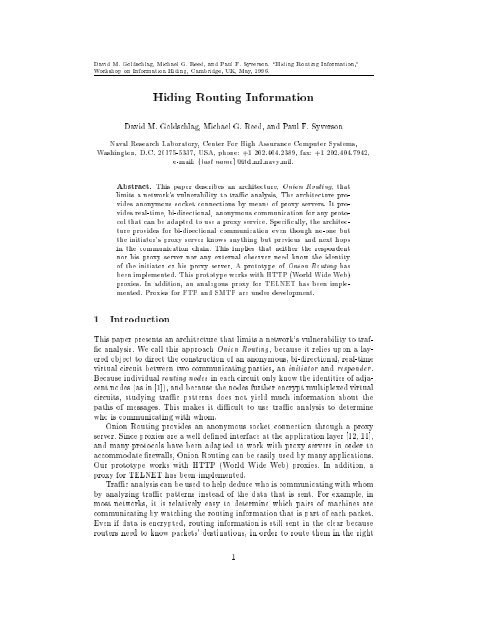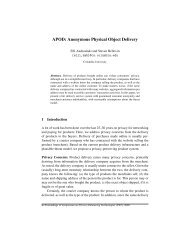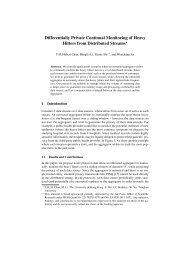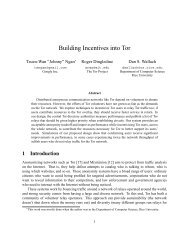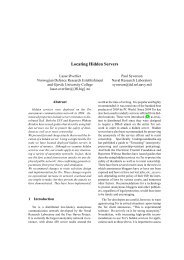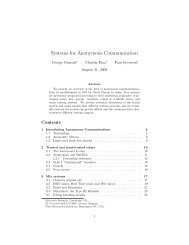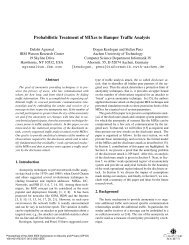Hiding Routing Information - Onion Routing
Hiding Routing Information - Onion Routing
Hiding Routing Information - Onion Routing
Create successful ePaper yourself
Turn your PDF publications into a flip-book with our unique Google optimized e-Paper software.
David M. Goldschlag, Michael G. Reed, and Paul F. Syverson. \<strong>Hiding</strong> <strong>Routing</strong> <strong>Information</strong>,"Workshop on <strong>Information</strong> <strong>Hiding</strong>, Cambridge, UK, May, 1996.<strong>Hiding</strong> <strong>Routing</strong> <strong>Information</strong>David M. Goldschlag, Michael G. Reed, and Paul F. SyversonNaval Research Laboratory, Center For High Assurance Computer Systems,Washington, D.C. 20375-5337, USA, phone: +1 202.404.2389, fax: +1 202.404.7942,e-mail: flast nameg@itd.nrl.navy.mil.Abstract. This paper describes an architecture, <strong>Onion</strong> <strong>Routing</strong>, thatlimits a network's vulnerability to trac analysis. The architecture providesanonymous socket connections by means of proxy servers. It providesreal-time, bi-directional, anonymous communication for any protocolthat can be adapted to use a proxy service. Specically, the architectureprovides for bi-directional communication even though no-one butthe initiator's proxy server knows anything but previous and next hopsin the communication chain. This implies that neither the respondentnor his proxy server nor any external observer need know the identityof the initiator or his proxy server. A prototype of <strong>Onion</strong> <strong>Routing</strong> hasbeen implemented. This prototype works with HTTP (World Wide Web)proxies. In addition, an analogous proxy for TELNET has been implemented.Proxies for FTP and SMTP are under development.1 IntroductionThis paper presents an architecture that limits a network's vulnerability to traf-c analysis. We call this approach <strong>Onion</strong> <strong>Routing</strong>, because it relies upon a layeredobject to direct the construction of an anonymous, bi-directional, real-timevirtual circuit between two communicating parties, an initiator and responder.Because individual routing nodes in each circuit only know the identities of adjacentnodes (as in [1]), and because the nodes further encrypt multiplexed virtualcircuits, studying trac patterns does not yield much information about thepaths of messages. This makes it dicult to use trac analysis to determinewho is communicating with whom.<strong>Onion</strong> <strong>Routing</strong> provides an anonymous socket connection through a proxyserver. Since proxies are a well dened interface at the application layer [12, 11],and many protocols have been adapted to work with proxy servers in order toaccommodate rewalls, <strong>Onion</strong> <strong>Routing</strong> can be easily used by many applications.Our prototype works with HTTP (World Wide Web) proxies. In addition, aproxy for TELNET has been implemented.Trac analysis can be used to help deduce who is communicating with whomby analyzing trac patterns instead of the data that is sent. For example, inmost networks, it is relatively easy to determine which pairs of machines arecommunicating by watching the routing information that is part of each packet.Even if data is encrypted, routing information is still sent in the clear becauserouters need to know packets' destinations, in order to route them in the right1
Gemeinde Bischofsheim Inhaltsverzeichnis Haushaltsplan 2009Kapitel /AbschnittSeite/n1. Haushaltssatzung 42. Vorbericht 83. Haushaltsplan 50• Gesamtergebnisplan und Gesamtfinanzplan 51• Teilergebnis- und Teilfinanzpläne, Investitionen,Produktblätter (Produktbeschreibung und Produktinformation)54‣ Budget 0 Gemeindeorgane (GO) 55• Produkt 111.01 Gemeindeorgane 58‣ Budget 1 Zentrale Dienste (ZD) 62• Produkt 111.11 Zentrale Dienstleistungen 65• Produkt 121.01 Wahlen 70‣ Budget 2 Sicherheit und Ordnung (SO) 74• Produkt 122.11 Sicherheit und Ordnung 77• Produkt 122.21 Bürgerservice 81• Produkt 122.31 Personenstandswesen 85• Produkt 126.01 Brand- und Katastrophenschutz 89‣ Budget 3 Soziales und Kultur (SK) 93• Produkt 242.01 Betreuungseinrichtungen für Schulkinder 96• Produkt 252.01 Museen, Archive, Sammlungen 100• Produkt 272.01 Bücherei 104• Produkt 281.01 Kulturarbeit 108• Produkt 315.01 Förderung der Seniorenarbeit 112• Produkt 331.01 Wohlfahrtspflege 116• Produkt 351.01 Sonstige soz. Angelegenheiten, Sozialberatung120• Produkt 362.01 Jugendarbeit 124• Produkt 365.01 Betreuungseinrichtungen für Kinder 128• Produkt 421.01 Förderung des Sports 1351
David M. Goldschlag, Michael G. Reed, and Paul F. Syverson. \<strong>Hiding</strong> <strong>Routing</strong> <strong>Information</strong>,"Workshop on <strong>Information</strong> <strong>Hiding</strong>, Cambridge, UK, May, 1996.piece of information that he retrieves is publicly known, it may be possible for anoutside observer to determine his sensitive interests by studying the patterns inhis requests. <strong>Onion</strong> <strong>Routing</strong> makes it very dicult to match his HTTP requeststo his site.Anonymous re-mailers [5, 6] attempt to limit the feasibility of trac analysisby providing an anonymous store and forward architecture. To prevent replayattacks, re-mailers keep a log of sent messages. These two characteristics makethe anonymous re-mailer approach unsuitable for HTTP applications, as HTTPrequests would both generate an enormous log and require bi-directional communication.Anonymous ISDN [8] has even more severe real-time and bi-directionalrequirements than HTTP, but, the architecture of an ISDN network is considerablydierent from the architecture of the Internet [4].<strong>Onion</strong> <strong>Routing</strong> provides bi-directional communication, without requiring thatthe responder know the initiator's identity or location. Individual messages arenot logged. In addition, <strong>Onion</strong> <strong>Routing</strong> is easily adapted to electronic mail.Messages can include Reply <strong>Onion</strong>s that permit a later reply to the senderwithout knowing his address and without keeping the original virtual circuitopen.The rest of the paper is organized in the following way: Section 2 presentsbackground information. Section 3 describes the <strong>Onion</strong>, the object that directsthe construction of the virtual circuit. Section 4 describes the construction anduse of these virtual circuits. Section 5 describes the vulnerabilities in the <strong>Onion</strong><strong>Routing</strong> architecture. Section 6 presents some concluding remarks.2 BackgroundChaum [1] denes a layered object that routes data through intermediate nodes,called mixes. These intermediate nodes may reorder, delay, and pad trac tocomplicate trac analysis. Some work has been done using mixes in ATM networks[3].Anonymous Remailers like [5, 6] use mixes to provide anonymous e-mailservices and also to invent an address through which mail can be forwarded backto the original sender. Remailers work in a store and forward manner at the mailapplication layer, by stripping o headers at each mix, and forwarding the mailmessage to the next mix. These remailers provide conrmation of delivery.In [8], mixes are used to provide untraceable communication in an ISDNnetwork. In a phone system, each telephone line is assigned to a particular localswitch (i.e., local exchange), and switches are interconnected by a (long distance)network. Anonymous calls in ISDN rely upon an anonymous connection withineach switch between the caller and the long distance network, which is obtainedby routing calls through a predened series of mixes. The long distance endpointsof the connection are then mated to complete the call. (Notice that observers cantell which local switches are connected.) This approach relies upon two uniquefeatures of ISDN switches. Since each phone line has a subset of the switch'stotal capacity pre-allocated to it, there is no (real) cost associated with keeping3
David M. Goldschlag, Michael G. Reed, and Paul F. Syverson. \<strong>Hiding</strong> <strong>Routing</strong> <strong>Information</strong>,"Workshop on <strong>Information</strong> <strong>Hiding</strong>, Cambridge, UK, May, 1996.a phone line active all the time, either by making calls to itself, to other phonelines on the same switch, or to the long distance network. Keeping phone linesactive complicates trac analysis because an observer cannot track coincidences.Also, since each phone line has a control circuit connection to the switch,the switch can broadcast messages to each line using these control circuits. So,within a switch a truly anonymous connection can be established: A phone linemakes an anonymous connection to some mix. That mix broadcasts a tokenidentifying itself and the connection. A recipient of that token can make anotheranonymous connection to the specied mix, which mates the two connections tocomplete the call.Our goal of anonymous socket connections over the Internet diers fromanonymous remailers and anonymous ISDN. The data is dierent, with real-timeconstraints more severe than mail, but somewhat looser than voice. Both HTTPand ISDN connections are bidirectional, but, unlike ISDN, HTTP connectionsare likely to be small requests followed by short bursts of returned data. In alocal switch capacity is pre-allocated to each phone line, and broadcasting isecient. But broadcasting over the Internet is not free, and dening broadcastsdomains is not trivial. Most importantly, the network topology of the Internetis more akin to the network topology of the long distance network betweenswitches, where capacity is a shared resource. In anonymous ISDN, the mixeshide communication within the local switch, but connections between switchesare not hidden. This implies that all calls between two businesses, each largeenough to use an entire switch, reveal which businesses are communicating. In<strong>Onion</strong> <strong>Routing</strong>, mixing is dispersed throughout the Internet, which improveshiding.3 <strong>Onion</strong>sTo begin a session between an initiator and a responder, the initiator's proxyidenties a series of routing nodes forming a route through the network andconstructs an onion which encapsulates that route. Figure 2 illustrates an onionconstructed by the initiator's Proxy/<strong>Routing</strong> Node W for an anonymous routeto the responder's Proxy/<strong>Routing</strong> Node Z through intermediate routing nodesX and Y . The initiator's proxy then sends the onion along that route to establisha virtual circuit between himself and the responder's proxy.The onion data structure is composed of layer upon layer of encryptionwrapped around a payload. Leaving aside the shape of the payload at the verycenter, the basic structure of the onion is based on the route to the responderthat is chosen by the initiator's proxy. Based on this route, the initiator's proxyencrypts rst for the responder's proxy, then for the preceding node on the route,and so on back to the rst routing node to whom he will send the onion. Whenthe onion is received, each node knows who sent him the onion and to whom heshould pass the onion. But, he knows nothing about the other nodes, nor abouthow many there are in the chain or his place in it (unless he is last). What a4
David M. Goldschlag, Michael G. Reed, and Paul F. Syverson. \<strong>Hiding</strong> <strong>Routing</strong> <strong>Information</strong>,"Workshop on <strong>Information</strong> <strong>Hiding</strong>, Cambridge, UK, May, 1996.Xexp_time x ,Y,F fx ,K fx ,F bx ,K bx ,Yexp_time y ,Z,F fy ,K fy ,F by ,K by ,Zexp_time z ,NULL,F fz ,K fz ,F bz ,K bz ,PADDINGFig. 2. AForward <strong>Onion</strong>.node P x receives looks like thisfexp time; next hop;F f ;K f ;F b ;K b ;payloadg PK xHere PK x is a public encryption key for routing node P x , who is assumedto have the corresponding decryption key. 1 The decrypted message contains anexpiration time for the onion, the next routing node to which the payload is tobe sent, the payload, and two function/key pairs specifying the cryptographicoperations and keys to be applied to data that will be sent along the virtualcircuit. The forward pair (F f ;K f ) is applied to data moving in the forwarddirection (along the route that the onion is traveling) the backward pair (F b ;K b )is applied to data moving in the opposite direction (along the onion's reverseroute). 2 (If the receiving node is the responder's proxy, then the next hop eldis null.) For any intermediate routing node the payload will be another onion.The expiration time is used to detect replays, which pairs of compromised nodescould use to try to correlate messages. Each node holds a copy of the onionuntil exp time. If he receives another copy of the same onion within that timehe simply ignores it. And, if he receives an onion that has expired, he ignoresthat as well.Notice that at each hop the onion shrinks as a layer is peeled o. To avoidcompromised nodes inferring route information from this monotonically diminishingsize, a random bit string the size of the peeled o layer is appended to theend of the payload before forwarding. No proxy except the last will know howmuch of the payload he receives is such padding because he won't know where1 Depending on certain assumptions about the elds in each onion layer, a naive RSAimplementation of the simple public key encryption implied by our notation couldbe vulnerable to an attack as described in [7]. In our implementation, this potentialvulnerability is illusory since the public key is only used to encrypt a secret key, andthat secret key is used to encrypt the remainder of the message using an ecientsymmetric algorithm. This also makes for a more ecient implementation than thesimple, straightforward implementation using only public keys.2 Specifying two pairs of functions unies the virtual circuits that are constructed byforward and reply onions. See section 3.3.5
David M. Goldschlag, Michael G. Reed, and Paul F. Syverson. \<strong>Hiding</strong> <strong>Routing</strong> <strong>Information</strong>,"Workshop on <strong>Information</strong> <strong>Hiding</strong>, Cambridge, UK, May, 1996.he is in the chain. He simply `decrypts' the padding along with the rest of theonion. Even a constant size onion might be traced unless all onions are the samesize, so we x the size of the onion. To maintain this constant size to hide thelength of the chain from the responder's proxy, the initiator's proxy will pad thecentral payload according to the size of the onion, i.e., the number of hops. So,when any onion arrives at the responder's proxy it will always have the sameamount of padding, either added initially or en route.3.1 Creating the circuitThe goal in sending the onion is to produce virtual circuits within link encryptedconnections already running between routing nodes. 3 More details will be givenin section 4. An onion occurs as the data eld in one of the presently described`messages'. Such messages contain a circuit identier, a command (create, destroy,and data), and data. Any other command is considered an error, and thenode who receives such a message ignores that message except to return a destroycommand back through that virtual circuit. The create command accompaniesan onion. When a node receives a create command along with an onion, hechooses a virtual circuit identier and sends another create message containingthis identier to the next node and the onion (padded with his layer peeledo). He also stores the virtual circuit identier he received and virtual circuitidentier he sent as a pair. Until the circuit is destroyed, whenever he receivesdata on the one connection he sends it o on the other. He applies the forwardcryptographic function and key (obtained from the onion) to data moving in theforward direction (along the route the onion traveled) and the backward cryptographicfunction and key to data moving in the opposite direction (along theonion's reverse route). The virtual circuit established by the onion in gure 2 isillustrated in gure 3:Data sent by the initiator over a virtual circuit is \pre-crypted" 4 repeatedlyby his proxy by applying the inverse of all the forward cryptographic operationsspecied in the onion, innermost rst. Therefore, these layers of cryptographywill be peeled o as the data travels forward through the virtual circuit. Datasent by the responder is \crypted" once by his proxy and again by each previousnode in the virtual circuit using the backward cryptographic operation speciedat the corresponding layer of the onion. The initiator's proxy applies the inverseof the backward cryptographic operations specied in the onion, outermost rst,to this stream, to obtain the plaintext.3.2 Loose <strong>Routing</strong>It is not necessary that the entire route be prespecied by the initiator's proxy.He can instruct various nodes along the route to choose their own route to the3 <strong>Onion</strong>s could be used to carry data also, but since onions have to be tracked toprevent replay, this would introduce a large cost.4 We dene the verb crypt to mean the application of a cryptographic operation, beit encryption or decryption, where the two are logically interchangeable.6
David M. Goldschlag, Michael G. Reed, and Paul F. Syverson. \<strong>Hiding</strong> <strong>Routing</strong> <strong>Information</strong>,"Workshop on <strong>Information</strong> <strong>Hiding</strong>, Cambridge, UK, May, 1996.Secure SiteInternetW is a Proxy/<strong>Routing</strong> Nodecontrolled by Secure SiteF bx,K bxW X UF fx,K fxF by,K byF bz,K bzInitiatorMachineYZResponderMachineF fy,K fyF fz,K fzData Flow (with Function/Key Pairs if crypted)Unsecured Socket ConnectionVirtual Circuit through Link Encrypted Connection Between <strong>Routing</strong> NodesLink Encrypted Connection Between <strong>Routing</strong> Nodes<strong>Routing</strong> Node<strong>Routing</strong>/Proxy NodeFig. 3. A Virtual Circuit.next prespecied node. This can be useful for security, adding more hops to thechain. It could also be used if the initiating proxy does not know a complete,connected route to the responder but believes that the node where any breakoccurs can construct a route to the next node. Or, loose routing can be used tohandle connection changes that occur of which the initiator was unaware. Also,since onions are all of xed size, there is a xed maximum length to the routefrom the initiator's proxy to the responder's proxy. Loose routing allows us toincrease the size of that maximum for the same xed onion size. Why this is soshould become clear presently.It is also possible to iterate the loose routing process, allowing nodes on theadded route to themselves add to the chain. Obviously, we need a mechanism toprevent the chain from lengthening indenitely. This can be incorporated intothe onion structure. An onion for a system that allows for loose routing is asfollows:fexp time; next hop; max loosecount;F f ;K f ;F b ;K b ;payloadg PK xIf the node receiving this onion decides to loose-route the onion, he preparesa new onion with up to max loosecount layers. The payload of this onion is7
David M. Goldschlag, Michael G. Reed, and Paul F. Syverson. \<strong>Hiding</strong> <strong>Routing</strong> <strong>Information</strong>,"Workshop on <strong>Information</strong> <strong>Hiding</strong>, Cambridge, UK, May, 1996.simply the onion he received with PK x changed for the last (innermost) nodehe added to the chain. In other words, he behaves as an initiator's proxy exceptthat his payload is itself already an onion. (This node behaves like an initiator'sproxy with respect to data also, since he must repeatedly pre- and post- cryptdata that moves along the diverted route.) To keep the onion a constant lengthhe must truncate the payload by an amount commensurate with the layers hehas added to the onion. The initiating proxy must anticipate the amount ofpadding (both present initially and any added and/or truncated en route) thatwill be on the central payload at the time loose routing occurs to allow for thistruncation. Failure to pre-pad correctly or ignoring an onion's xed size willresult in a malformed onion later in the route. The total of the max loosecountvalues occurring in the added layers plus the number of added layers must beless than or equal to the max loosecount value that the adding node received.3.3 Reply <strong>Onion</strong>sThere are applications in which itwould be useful for a responder to send backa reply after the original circuit is broken. This would allow answers (like e-mailreplies) to be sent to queries that were not available at the time of the originalconnection. As we shall see presently, this also allows the responder as well asthe initiator to remain hidden. The way we allow for these delayed replies is bysending a reply onion to accompany the reply. Like the forward onion, it revealsto each node en route only the next step to be taken. It has the same structure asthe forward onion and is treated the same way by nodes en route. Intermediatenodes processing an onion cannot dierentiate between forward and reply onions.Furthermore, the behavior of the original initiator and responder proxies are thesame, once the circuit is formed.The primary dierence between a forward and a reply onion is the innermostpayload. The payload of the forward onion can be eectively empty (containingonly padding). The reply onion payload contains enough information to enablethe initiator's proxy to reach the initiator and all the cryptographic function andkey pairs that are to crypt data along the virtual circuit. The initiator's proxyretrieves the keys from the onion. Figure 4 illustrates a reply onion constructedby the initiator's Proxy/<strong>Routing</strong> Node W for an anonymous route back tohimstarting at the responder's Proxy/<strong>Routing</strong> Node Z through intermediate routingnodes Y and X:There is no dierence between virtual circuits established by reply onionsand forward onions, except that in circuits established by reply onions intermediaterouting nodes appear to think that forward points toward the initiator'sproxy. But since the behavior of intermediate routing nodes is symmetric, thisdierence is irrelevant. The terminal Proxy/<strong>Routing</strong> nodes, however, have thesame behavior in circuits established by forward and reply onions. Therefore, agure of the virtual circuit formed by the reply onion illustrated in gure 4 wouldbe identical to the virtual circuit illustrated in gure 3 even though the circuitwas formed by the reply onion moving from the responder's proxy node to the8
David M. Goldschlag, Michael G. Reed, and Paul F. Syverson. \<strong>Hiding</strong> <strong>Routing</strong> <strong>Information</strong>,"Workshop on <strong>Information</strong> <strong>Hiding</strong>, Cambridge, UK, May, 1996.Zexp_time z ,Y,F bz ,K bz ,F fz ,K fz ,Yexp_time y ,X,F by ,K by ,F fy ,K fy ,Xexp_time x ,W,F bx ,K bx ,F fx ,K fx ,W exp_timew ,NULL,NULL,NULL,NULL,NULL,{IDENTITY,F bx ,K bx ,F fx ,K fx ,F by ,K by ,F fy ,K fy ,F bz ,K bz ,F fz ,K fz ,PADDING}Fig. 4. A Reply <strong>Onion</strong>.initiator's proxy node. Internally to the intermediate nodes, the forward cryptographicfunctions are applied to data moving in the direction that the circuit wasestablished, and the backward cryptographic functions are applied to data movingin the opposite direction. The location of the terminal Proxy/<strong>Routing</strong> Nodesare in this sense reversed, with the initiator's proxy at the end of the circuit andthe responder's proxy at the beginning of the circuit. However, the behavior ofthe initiator and responder proxies is identical to their behavior in the virtualcircuit formed by a forward onion. This is the reason for having forward andbackward function/key pairs at each layer of the onion.Like a forward onion, a reply onion can only be used once. When a nodereceives an onion it is kept until it expires, and any onion received is comparedto detect replay. If a replay is detected, it is treated as an error and ignored.Since reply onions can only be used once, if multiple replies are desired, multiplereply onions must be sent. Of course, they need not all follow the same returnroute; although they may. If replies are only likely to be forthcoming if they areanonymous, one or more reply onions can be broadcast. Anyone can then replywith an unused onion. If he can maintain anonymity from or in cooperation withthe responder's proxy for that reply onion, then he can do so anonymously.4 ImplementationThe easiest way to build our system without requiring the complete redesign anddeployment of new client and server software is to make use of existing proxytechnologies. Historically, proxy technologies have been used to create tunnelsthrough a rewall. The use of proxy technologies requires that the client applicationsbe `proxy aware'. The widespread deployment of rewalls on the Internethas created the demand for such proxy aware applications, which software manufacturersare rushing to meet.9
David M. Goldschlag, Michael G. Reed, and Paul F. Syverson. \<strong>Hiding</strong> <strong>Routing</strong> <strong>Information</strong>,"Workshop on <strong>Information</strong> <strong>Hiding</strong>, Cambridge, UK, May, 1996.In the rewall setting, a system administrator will set up a proxy server onthe rewall machine which will be responsible for forwarding requests from theprotected domain out onto the open Internet, and maintain a return path forthe response to the request. A proxy server can be divided into two parts: thefront end that receives and parses the request, and the back end that processesthe request and returns the results back to the requester. Classically, the frontand back ends are the same process running on one machine.Under our system we will use a traditional proxy front end and back end, but,they will be separate processes on separate machines with a tunnel connectingthem. In this manner, our Proxy/<strong>Routing</strong> Nodes will look no dierent totheclient and server software than any other proxy server. A couple of assumptionswill hold for the remainder of this paper: 1) Proxy/<strong>Routing</strong> Nodes and intermediaterouting nodes know about each other in advance of their operation, and 2)public key certicates for each nodehave been securely distributed to all othersprior to operation.All nodes are connected by link encrypted connections which multiplex manyvirtual circuits between initiator and responder proxy nodes. These connectionsare link encrypted in an odd way (for eciency). All messages moving throughthese connections are of xed size and have two components, header and payloadelds. Header elds contain the virtual circuit identier and the command andare link encrypted using a stream cipher [10]. Since all payload elds will beencrypted via other mechanisms (public keys or onion keys), they need not belink encrypted.There are three commands that nodes understand. The rst is to create avirtual circuit. At each node, a virtual circuit has two connections. Data arrivingon one is passed along on the other. The circuit is dened by the labelsfor these two connections. Creating a virtual circuit is the process of deningthese labels for each node along the route. For the rst Proxy/<strong>Routing</strong> Node,one connection is a link to the initiator, and the other is a link to the nextrouting node. The Proxy/<strong>Routing</strong> Node creates an onion dening the sequenceof intermediate routing nodes to the responder's Proxy/<strong>Routing</strong> Node. It breaksthe onion up into payload sized chunks and transmits these chunks in order tothe next node with a control eld containing both the label of the connectionand a create command. Each subsequent node reassembles the onion and peelso a layer from the onion which reveals the next node in the route and two cryptographicfunction/key pairs. Before acting on the create command, the nodechecks whether the onion has expired or is a replay. Tocheck for replay, the nodeconsults a table of unexpired onions. If the onion is valid, it is inserted into thetable, and the node then labels a new connection to the next node and passes thepeeled and padded onion in a similar sequence of messages to the next node. Italso updates a table containing the labels and cryptographic function/key pairsassociated with the new virtual circuit. The appropriate (forward or backward)function/key pair should be used to crypt data moving along that circuit. Theresponder's Proxy/<strong>Routing</strong> Node, recognizing that the onion is empty, will partiallyupdate its tables. As with standard proxies the next data message along10
David M. Goldschlag, Michael G. Reed, and Paul F. Syverson. \<strong>Hiding</strong> <strong>Routing</strong> <strong>Information</strong>,"Workshop on <strong>Information</strong> <strong>Hiding</strong>, Cambridge, UK, May, 1996.this circuit will identify the responder.The second command is data. The second role of the initiator's Proxy/<strong>Routing</strong>Node is to pass a stream of data from the initiator along the virtual circuittogether with other control information for the responder's Proxy/<strong>Routing</strong> Node.To do this, he breaks the incoming stream into (at most) payload sized chunks,and repeatedly pre-crypts each chunk using the inverse of the cryptographicoperations specied in the onion, innermost rst. The function/key pairs thatare applied, and the virtual circuit identier of the connection to the next nodeare obtained from a table. The header eld for each payload is the label ofthe connection and a data command. Each subsequent node looks at its table,obtaining the cryptographic function/key pair associated with the circuit (forthe appropriate direction) and the virtual circuit identier of the connection tothe next node. It then peels o a layer of cryptography and forwards the peeledpayload to the next node. Once the data reaches the responder's proxy, its nalcryption will produce the plaintext that is to be processed or forwarded to theresponder.The data command can also be used to move data from the responder'sProxy/<strong>Routing</strong> Node to the initiator's Proxy/<strong>Routing</strong> Node. The responder'sProxy/<strong>Routing</strong> Node obtains the cryptographic function/key pair and the virtualcircuit identier for the next node from its tables, and crypts the stream.It breaks the crypted stream into payload sized chunks and forwards them tothe next node with the appropriate control eld. Each subsequent node furtherstream crypts each payload using the appropriate function/key associated withthat virtual circuit. Once a messages arrives at the initiator's Proxy/<strong>Routing</strong>Node he looks at his table and applies the inverse of the backward cryptographicoperations specied in the onion, outermost rst, to this stream to obtain theplaintext. The plaintext is forwarded to the initiator.The third command is destroy which is used to tear down a virtual circuitwhen it is no longer needed or in response to certain error conditions. Noticethat destroy messages can be initiated by any node along a virtual circuit, and itis a node's obligation to forward the destroy messages in the appropriate directions.(A node initiating a destroy message in an active virtual circuit forwardsit in both directions. A node that receives a destroy message passes it alongin the same direction.) The payload of a destroy command is empty padding.Nonetheless, this payload is still crypted with the appropriate function/key pair.In addition to the destroy command, the control eld contains the virtual circuitidentier of the recipient of the destroy command. Upon receipt of a destroycommand a node deletes the table entries associated with that virtual circuit.5 Vulnerabilities<strong>Onion</strong> <strong>Routing</strong> is not invulnerable to trac analysis attacks. With enough data,it is still possible to analyze usage patterns and make educated guesses aboutthe routing of messages. Also, since our application requires real time communication,it may be possible to detect the near simultaneous opening of socket11
David M. Goldschlag, Michael G. Reed, and Paul F. Syverson. \<strong>Hiding</strong> <strong>Routing</strong> <strong>Information</strong>,"Workshop on <strong>Information</strong> <strong>Hiding</strong>, Cambridge, UK, May, 1996.connections on the rst and last proxy servers revealing who is requesting whatinformation. However, these sorts of attacks require the collection and analysisof huge amounts of data by external observers.Other attacks depend upon compromised Proxy Servers and <strong>Routing</strong> Nodes.If the initiator's proxy is compromised then all information is revealed. In generalit is sucient for a single routing node to be uncompromised to complicate tracanalysis. However, a single compromised routing node can destroy connectionsor stop forwarding messages, resulting in denial of service attacks.<strong>Onion</strong> <strong>Routing</strong> uses expiration times to prevent replay attacks. It is curiousthat, unlike timestamps, the vulnerability due to poorly synchronized clocks hereis a denial of service attack, instead of a replay attack. If a node's clock istoofast, otherwise timely onions will appear to have already expired. Also, sinceexpiration times dene the window during which nodes must store used onions,a node with a slow clock will end up storing more information.If the responder's proxy is compromised, and can determine when the unencrypteddata stream has been corrupted, it is possible for compromised nodesearlier in the virtual circuit to corrupt the stream and ask which responder'sproxy received uncorrupted data. By working with compromised nodes around asuspected initiator's proxy, one can identify the beginning of the virtual circuit.The diculty with this attack is that once the data stream has been corrupted, itwill remain corrupted (because we use a stream cipher), limiting further analysis.In order for <strong>Onion</strong> <strong>Routing</strong> to be eective, there must be signicant use of allthe nodes, and Proxy Nodes must also be intermediate routing nodes. Choosingthe appropriate balance between ecient use of network capacity and security isa hard problem both from a theoretical and practical standpoint. Theoretically,it is dicult to calculate the value of the tradeo. For more security, networktrac must be relatively constant. This requires sending dummy trac over aconnection when trac is light and buering data when trac is heavy. If tracis very bursty and response time is important, smoothing out network tracrequires wasting capacity. Ifhowever, trac is relatively constant, additionalsmoothing may not be necessary. From a practical point of view, the Internetmay not provide the control necessary to smooth out trac: unlike ATM, usersdo not own capacity on shared connections. The important observation, however,is that <strong>Onion</strong> <strong>Routing</strong> forms an architecture within which these tradeos can bemade and explored.6 Conclusion<strong>Onion</strong> <strong>Routing</strong> is an architecture that hides routing information while providingreal-time, bi-directional communication. Since it provides a virtual circuit thatcan replace a socket connection, <strong>Onion</strong> <strong>Routing</strong> can be used in any protocol thatcan be adapted to use a proxy service. Although our rst use is in HTTP andTELNET, it is easy to imagine other applications. In e-mail, for example, <strong>Onion</strong><strong>Routing</strong> would create an anonymous socket connection between two sendmaildaemons. This contrasts with Anonymous Remailers, where each remailer pro-12
David M. Goldschlag, Michael G. Reed, and Paul F. Syverson. \<strong>Hiding</strong> <strong>Routing</strong> <strong>Information</strong>,"Workshop on <strong>Information</strong> <strong>Hiding</strong>, Cambridge, UK, May, 1996.vides a single hop in a chain of mail forwarding. In this sense, in <strong>Onion</strong> <strong>Routing</strong>,the rerouting of messages is independent of the type of message.Other extensions are also possible and integrate nicely with the proxy approachto anonymity. For example, to create a completely anonymous conversationbetween two parties, each party would make an anonymous connectionto some anonymity server, which mates connections sharing some token. Thisapproach, similar to IRC servers, can also be used if the responder does not trustthe initiator, especially with (broadcast) reply onions. The responder builds hisown (trusted) connection to some anonymity server, and asks that anonymityserver to build another connection to the initiator using a reply onion and tomate the two connections. Each party is therefore protected by a route that hedetermined.In <strong>Onion</strong> <strong>Routing</strong> the encryption burden on connected intermediate nodes isless than the burden of link encryption on routers. In link encryption, each packetis encrypted by the sender and decrypted by the recipient. In <strong>Onion</strong> <strong>Routing</strong>the header and payload of each message are crypted separately: the header isencrypted and decrypted using the connection's key, and the payload is crypted(only by the recipient) using the appropriate function/key pair associated withthe virtual circuit.Our goal here is not to provide anonymous communication, but, to place identicationwhere it belongs. The use of a public network should not automaticallyreveal the identities of communicating parties. If anonymous communication isundesirable, it is easy to imagine lters on the endpoint machines that restrictcommunication to signed messages.<strong>Onion</strong> <strong>Routing</strong> will only be eective in complicating trac analysis if itsProxy and <strong>Routing</strong> Nodes become widespread and widely used. There is an obvioustension between anonymity and law enforcement. If this tension is resolvedin favor of law enforcement, it would be straightforward to integrate a key escrowsystem within the onion, which would make routing information available to thelawful authorities.7 AcknowledgementsDiscussions with many people helped develop the ideas in this paper. We wouldlike to thank Ran Atkinson, Markus Jakobbsen, John McLean, Cathy Meadows,Andy Moore, Moni Naor, Holger Peterson, Birgit Ptzmann, Michael Steiner,and the anonymous referees for their helpful suggestions.References1. D. Chaum. Untraceable Electronic Mail, Return Addresses, and DigitalPseudonyms, Communications of the ACM, v. 24, n. 2, Feb. 1981, pages 84-88.2. D. Chaum, The Dining Cryptographers Problem: Unconditional Sender and RecipientUntraceability, Journal of Cryptology, 1/1, 1988, pages 65-75.13
David M. Goldschlag, Michael G. Reed, and Paul F. Syverson. \<strong>Hiding</strong> <strong>Routing</strong> <strong>Information</strong>,"Workshop on <strong>Information</strong> <strong>Hiding</strong>, Cambridge, UK, May, 1996.3. S. Chuang. Security Management of ATM Networks, Ph.D. thesis, in progress,Cambridge University.4. D. E. Comer. Internetworking with TCP/IP, Volume 1: Principles, Protocols, andArchitecture, Prentice{Hall, Engelwood Clis, New Jersey, 1995.5. L. Cottrell. Mixmaster and Remailer Attacks,http://obscura.obscura.com/e loki/remailer/remailer-essay.html6. C. Gulcu and G. Tsudik. Mixing Email with Babel, 1996 Symposium on Networkand Distributed System Security, San Diego, February 1996.7. A. Ptzmann and B. Ptzmann. How to Break the Direct RSA-implementation ofMIXes, Advances in Cryptology{EUROCRYPT '89 Proceedings, Springer-Verlag,Berlin, 1990, pages 373-381.8. A. Ptzmann, B. Ptzmann, and M. Waidner. ISDN-Mixes: Untraceable Communicationwith Very Small Bandwidth Overhead, GI/ITG Conference: Communicationin Distributed Systems, Mannheim Feb, 1991, Informatik-Fachberichte 267,Springer-Verlag, Heildelberg 1991, pages 451-463.9. A. Ptzmann and M. Waidner. Networks Without User Observability, Computers& Security, 6/2 1987, pages 158-166.10. B. Schneier. Applied Cryptography: Protocols, Algorithms and Source Code in C,John Wiley and Sons, 1994.11. W. R. Stevens. TCP/IP Illustrated, Volume 3: TCP for Transactions, HTTP,NNTP, and the UNIX Domain Protocols, Addison{Wesley, Reading, Mass., 1996.12. L. D. Stein. How to Set up and Maintain a World Wide Web Site: The Guide for<strong>Information</strong> Providers, Addison{Wesley, Reading, Mass., 1995.This article was processed using the LATEX macro package with LLNCS style14


